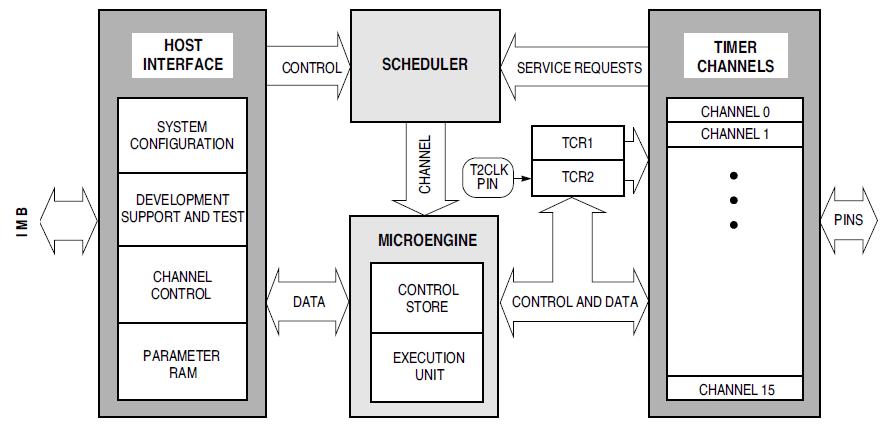App Note TPUPN00: Using the TPU Function Library and TPU Emulation Mode
137.3KB PDF
NEW! App note in HTML format
Mask A Source (Timing/Counting)
Click here to download the entire Mask A Source| Function | Name | App Notes (PDF) | HTML |
| PPWA | Period/Pulse-Width Accumulate | TPUPN11 | Coming Soon |
| OC | Output Compare | TPUPN12 | Coming Soon |
| SM | Stepper Motor | TPUPN13 | Coming Soon |
| PSP | Position-Synchronized Pulse Generator | TPUPN14 | Coming Soon |
| PMA | Period Measurement with Additional transition | TPUPN15A | Coming Soon |
| PMM | Period Measurement with Missing transition | TPUPN15B | Coming Soon |
| ITC | Input Capture/Input Transition Counter | TPUPN16 | Coming Soon |
| PWM | Pulse Width Modulation | TPUPN17 | Coming Soon |
| DIO | Discrete Input/Output | TPUPN18 | Coming Soon |
| SPWM | Synchronized Pulse-Width Modulation | TPUPN19 | Coming Soon |
| QDEC | Quadrature Decode | TPUPN20 | TPUPN20 |
Mask G Source (General/Motion Control)
Click here to download the entire Mask G (Rev. A) SourceClick here to download the entire Mask G (Rev. C) Source
| Function | Name | App Notes (PDF) | HTML |
| PTA | Pulse/Time Accumulate | TPUPN06 | Coming Soon |
| QOM | Queued Output Match | TPUPN01 | TPUPN01 |
| TSM | Table Stepper Motor | TPUPN04 | Coming Soon |
| FQM | FreQuency Measurement | TPUPN03 | Coming Soon |
| UART | Universal Asynchronous Receiver/Transmitter | TPUPN07 | Coming Soon |
| NITC | New Input Transition Counter | TPUPN08 | Coming Soon |
| COMM | COMMutation | TPUPN09 | Coming Soon |
| HALLD | HALL-effect Decode | TPUPN10 | Coming Soon |
| MCPWM | Multi-Channel Pulse Width Modulation | TPUPN05 | Coming Soon |
| FQD | Fast Quadrature Decode | TPUPN02 | Coming Soon |
Miscellaneous Function Source
Click here to download the Miscellaneous Functions| Function | Name |
| SQW | SQuare Wave |
| RECTW | RECTangular Wave |
| RECTW2 | RECTangular Wave 2 |
| MHT | Measure High Time |
| MHT2 | Measure High Time 2 |
| SIOP | Serial Input Output Port |
| RWTPIN | Read/Write Timer and Pins |
| DCPM | Degree Clock with Period Measurement |
TPU Engineering Bulletins
TPU Manuals and Information
Arno Morbach's TPU I2C Function
Description
This function provides an easy way to connect IIC devices to the 68332 or 68376. Two adjacent channels are used, the first one provides the user inter- face. The function has been tested with IIC EEPROMs, but it should work with several other IIC slaves. Since the TPU is always master of the IIC bus, there is no limit of the response time. If there are other TPU functions, the transfer time will go up, but it will not be disturbed. The following description assumes, that you are familiar with the IIC bus and its addressing scheme.
Arno writes:
"I would like to hear if someone really used this function because I only did some tests with an I2C-EEPROM. Any comments to the function or suggestions would be welcome."-Arno Morbach
Download the zipped source (7KB)
Eric Dönges' TPU ALARM CLOCK Function
Description
This function provides a 32 bit alarm clock with a fixed reference time. This time can be reset any time; all alarm times are relative to this value.Download the zipped source (4KB)
Motorola Tools
TPU Macro Assembler v. 3.33 (Beta)TPU Debugger v 1.13
Background Debug Mode Driver Package for Motorola's 16- and 32-Bit Microcontrollers
Zoltan Kocsi's TPU Assembler
Zoltán writes:
Tas is an assembler that assembles the Motorola Time Processor Unit microcode... I wrote the assembler for it because there are only two other versions that I know of: An official assembler, that you can buy from Motorola and runs on Windows (maybe DOS too, used to be DOS only) and a free version, from Motorola again, that runs under DOS. The Windows one comes with extensive docs, the free one with none. In addition, Motorola does not give you the microcode programming docs without buying the official assembler. This policy IMHO sucks, but that's not relevant now. By the way, the document is called TPUMASMREF/D1. Since I do not use Windows and try not to use DOS either, I decided to write an assembler myself that I can use on Linux. Armed with my 5 year old docs I jumped on it and this assembler is the result."-Zoltan Kocsi (a.k.a. Kocsonya)
Bendor Research Pty. Ltd.
Bill Knight's C Implementation of a TPU-based UART
Bill writes:
"I have not re-compiled this to ensure everything is resolved, but I also haven't changed ANY of the actual code. Two more things. 1) Portions of the code were "pulled in" from various application notes, etc. and 2) PLEASE NOTE THAT THE ASM STATEMENTS IN THE ACTUAL ISRs DEPEND UPON WHICH TPU CHANNELS ARE ACTUALLY USED. Oh yes, this code was written to use the SDS CrossCode compiler and may require changes for other compilers."-Bill Knight
R O SoftWare
Download the zipped source (9KB)
| Main Page | | | Manuals, Source Code, & Tools | | | Links |
2008/4/13: FINALLY added Appendix B of TPU/RM
2004/1/15: Added Scott Howards' BDM Driver Package
2002/7/26: Added Eric Dönges' Alarm Clock Function source
2001/4/12: Added Zoltán Kócsi's Tas TPU Assembler
2000/12/21: Added Arno Morbach's I2C Function source
2000/12/19: Added Bill Knight's UART source
2000/6/6: Created this download page
You are visitor
Last modified:
